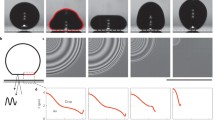Abstract
Consistent droplet bouncing driven by AC electrowetting was achieved by introducing a superhydrophobic surface instead of conventional hydrophobic surfaces. A superhydrophobic surface is very effective to reduce interfacial energy barrier or adhesion, allowing complete detachment of a droplet from the substrate. While a fixed electric potential (100 Vrms) was applied, the shape deformation and the droplet bouncing were significantly influenced by the frequency of the AC electrowetting. Consistent droplet bouncing only occurred at very narrow frequency ranges (e.g., 30–31 Hz for 8 μL droplets), indicating that resonance dominates the droplet bouncing. Interestingly, the resonance was 1/2 sub-harmonics, where every other actuation was skipped, when the droplet was in the air. Theoretical evaluation of the resonant frequency based on the linear theory implies that the fundamental resonance between the AC electrowetting and the vertical vibration of the shape oscillation could be important to produce consistent droplet bouncing.
Graphical Abstract






Similar content being viewed by others
References
Berge B, Peseux J (2000) Variable focal lens controlled by an external voltage: an application of electrowetting. Eur Phys J E 3(2):159–163
Cho SK, Moon H, Kim CJ (2003) Creating, transporting, cutting, and merging liquid droplets by electrowetting-based actuation for digital microfluidic circuits. J Microelectromech Syst 12(1):70–80
Hayes RA, Feenstra BJ (2003) Video-speed electronic paper based on electrowetting. Nature 425(6956):383–385
Kang KH (2002) How electrostatic fields change contact angle in electrowetting. Langmuir 18(26):10318–10322
Oh JM, Ko SH, Kang KH (2008) Shape oscillation of a drop in ac electrowetting. Langmuir 24(15):8379–8386
Pollack MG, Fair RB, Shenderov AD (2000) Electrowetting-based actuation of liquid droplets for microfluidic applications. Appl Phys Lett 77(11):1725–1726
Srinivasan V, Pamula VK, Fair RB (2004) An integrated digital microfluidic lab-on-a-chip for clinical diagnostics on human physiological fluids. Lab Chip 4:310–315
Acknowledgments
This work was supported by the Korea Science and Engineering Foundation (R0A-2007-000-20098-0) and the National Research Foundation of Korea (NRF) Grant (No. 20090083510) by the Korean government (MEST) through Multi-phenomena CFD Engineering Research Center.
Author information
Authors and Affiliations
Corresponding author
Rights and permissions
About this article
Cite this article
Lee, S.J., Lee, S. & Kang, K.H. Jumping of a droplet on a superhydrophobic surface in AC electrowetting. J Vis 14, 259–264 (2011). https://doi.org/10.1007/s12650-011-0076-z
Received:
Accepted:
Published:
Issue Date:
DOI: https://doi.org/10.1007/s12650-011-0076-z




